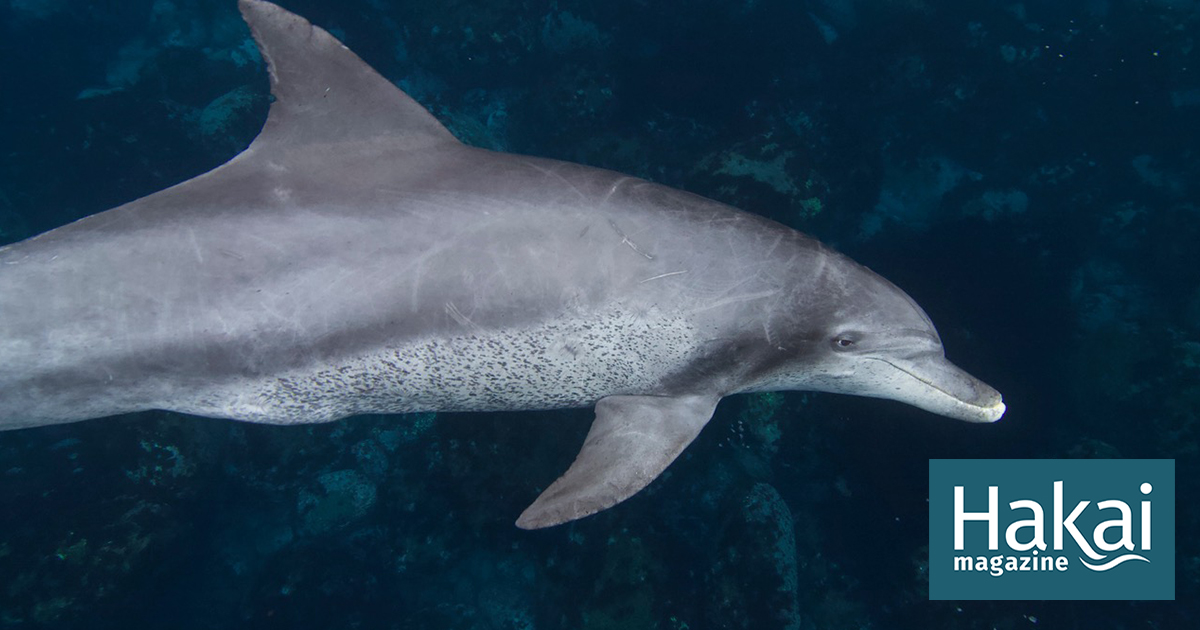
Article body copy
As humans age, our bodies are often graced with fine lines, gray hairs, and flecks of hyperpigmentation on our skin known as age spots. Indo-Pacific bottlenose dolphins get spots with age, too. And as scientists have revealed in a recent study, the onset of dolphins’ speckling is so predictable it can be a noninvasive way to gauge the dolphins’ age.
Age is a crucial metric for understanding dolphin populations. Many ways of calculating a dolphin’s age exist, such as counting the layers of dental material in their teeth or analyzing DNA from a skin sample. But they’re all somewhat invasive. That’s why developing a model for estimating age by simply looking at dolphins’ dots is so interesting.
Ewa Krzyszczyk, a dolphin researcher at Bangor University in Wales who was not involved in the study, says the new technique “is a really useful tool.” By estimating a dolphin’s age, Krzyszczyk says, scientists can answer important questions, such as when a dolphin stops weaning, when it reaches sexuality maturity, or when a dolphin shows signs of deterioration from old age. “It gives a more well-rounded idea of what’s going on in your population that can then help with conservation,” she says.
Indo-Pacific bottlenose dolphins’ spots propagate up their bodies in a reliable way, offering a way for scientists to unobtrusively gauge a dolphin’s age. Video courtesy of Genfu Yagi
The discovery that dolphins’ dots reflect aging stems from research led by Genfu Yagi, a marine mammal researcher at Mie University in Japan. Previously, Yagi had analyzed a compendium of underwater footage taken of Indo-Pacific bottlenose dolphins off the coast of Mikura Island, near central Japan. Since many of the individual dolphins were known from birth, Yagi could trace how their speckles emerged as they grew.
“The speckles first appear around the genital slit at 6.5 years of age,” says Yagi. Over time, he says, this treasure trail expands toward the head and up toward the back. By the time dolphins are around eight years old, speckles start on their chest, and by around 17, the spots reach their jaw. Wild bottlenose dolphins typically live between 30 and 50 years.
To use these speckles to estimate age, Yagi created a new system that quantifies the density of speckles on various parts of the body. This weighted speckle density score is then correlated with age. Yagi says his speckle-counting method works for dolphins between the ages of seven and 25 and has a margin of error of 2.58 years—more accurate than estimating age from DNA samples.
“The strength of this study is that it does not require special techniques, facilities, high costs, or any invasive surveying,” says Yagi. “Anyone can estimate a dolphin’s age.”
At the moment, Yagi’s formula can only be used for the Mikura Island Indo-Pacific bottlenose dolphin population because speckling onset could differ between geographic locations. He says, however, that the same modeling technique could work for other dolphin populations.
So far, dolphins are the only cetacean known to develop spots, with pantropical and Atlantic spotted dolphins getting dark spots on their bellies and light spots on their backs. Yagi says scientists don’t know exactly how or why these speckles form.
“This is a very rare trait, as few mammals other than dolphins continue to change body coloration throughout their lives,” he says.
https://news.google.com/rss/articles/CBMiTmh0dHBzOi8vaGFrYWltYWdhemluZS5jb20vbmV3cy9hbm90aGVyLWFuaW1hbC10aGF0LXNwZWNrbGVzLXdpdGgtYWdlLWRvbHBoaW5zL9IBAA?oc=5
2023-03-22 07:01:24Z
CBMiTmh0dHBzOi8vaGFrYWltYWdhemluZS5jb20vbmV3cy9hbm90aGVyLWFuaW1hbC10aGF0LXNwZWNrbGVzLXdpdGgtYWdlLWRvbHBoaW5zL9IBAA
Tidak ada komentar:
Posting Komentar